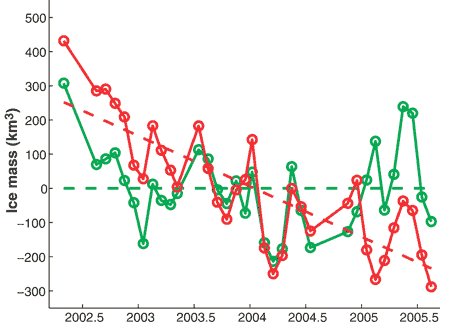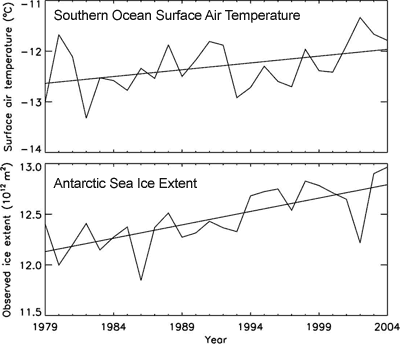
Figure 1: Ice mass changes (solid lines with circles) and their best-fitting linear trends (dashed line) for the West Antarcica Ice Sheet (red) and East Antarcica Ice Sheet (green) for April 2002 to August 2005 (Velicogna 2007).
A common error when discussing Antarctic ice trends is to confuse land ice and sea ice. Simply put, land ice is decreasing while sea ice is increasing. I discuss both trends in more detail in Is Antarctica losing or gaining ice? Disappointingly, even after distinguishing between land ice and sea ice, there are still repeated comments confusing the two (eg - here, here and even an accusation of misinformation). Why is this? Perhaps people are not paying attention. Possibly, it's the result of many articles that confuse the two phenomenon. In How to cherry pick your way to Antarctic land ice gain, we see how one article blurs the line between sea ice and land ice to convince people that Antarctica is gaining land ice. Apparently, this technique is all too successful. Or maybe I just didn't explain it clearly enough. As the third possibility is the only one I can do anything about, I've revamped the Antarctic ice page, hopefully clarifying the issue somewhat. I've also added some recent research and simplified the explanation of sea ice trends. To summarise the situation with Antarctic ice trends:
Measuring changes in Antarctic land ice mass has been a difficult process due to the ice sheet's massive size and complexity. However, since 2002 the Gravity Recovery and Climate Experiment (GRACE) satellites have been able to comprehensively survey the entire ice sheet. The satellites measure changes in gravity to determine mass variations of the entire Antarctic ice sheet. Initial observations found that that most of Antarctic mass loss comes from Western Antarctica (Velicogna 2007). Meanwhile, East Antarctica is in approximate mass balance. The ice gained in the interior is roughly balanced by the ice loss at the edges. This is illustrated in Figure 1 which contrasts the ice mass changes in West Antarctica (red) compared to East Antarctica (green):

Figure 1: Ice mass changes (solid lines with circles) and their best-fitting linear trends (dashed line) for the West Antarcica Ice Sheet (red) and East Antarcica Ice Sheet (green) for April 2002 to August 2005 (Velicogna 2007).
As more GRACE data came in, a clearer understanding of the Antarctic ice sheet emerges. Figure 2 shows the ice mass changes in Antarctica for the period April 2002 to February 2009 (Velicogna 2009) . The blue line/crosses show the unfiltered, monthly values. The red crosses have seasonal variability removed. The green line is the best fitting trend.

Figure 2: Ice mass changes for the Antarctic ice sheet from April 2002 to February 2009. Unfiltered data are blue crosses. Data filtered for the seasonal dependence are red crosses. The best-fitting quadratic trend is shown as the green line (Velicogna 2009).
With the longer time series, a statistically significant trend now emerges. Not only is Antarctica losing land ice, the ice loss is accelerating at a rate of 26 Gigatonnes/yr2. The Antarctic ice sheet plays an important role in the total contribution to sea level. That contribution is continuously and rapidly growing.
Antarctic sea ice has shown long term growth since satellites began measurements in 1979. This is an observation that has been often cited by skeptics as proof against global warming. However, rarely is the question raised: why is Antarctic sea ice increasing? The implicit assumption is that if Antarctic sea ice is growing, it must be cooling around Antarctica. This is decidely not the case. In fact, the Southern Ocean has been warming faster than the rest of the world's oceans. Globally from 1955 to 1995, ocean have been warming at 0.1°C per decade. In contrast, the Southern Ocean has been warming at 0.17°C per decade. Not only is the Southern Ocean warming, it is warming faster than the global trend.

Figure 3: Surface air temperature over the ice-covered areas of the Southern Ocean (top). Sea ice extent, observed by satellite (bottom). (Zhang 2007)
If the Southern Ocean is warming, why is Antarctic sea ice increasing? There are several contributing factors. One is the drop in ozone levels over Antarctica. The hole in the ozone layer above the South Pole has caused cooling in the stratosphere (Gillet 2003). This strengthens the cyclonic winds that circle the Antarctic continent (Thompson 2002). The wind pushes sea ice around, creating areas of open water known as polynyas. More polynyas leads to increased sea ice production (Turner 2009).
Another contributor is changes in ocean circulation. The Southern Ocean consists of a layer of cold water near the surface and a layer of warmer water below. Water from the warmer layer rises up to the surface, melting sea ice. However, as air temperatures warm, the amount of rain and snowfall also increases. This freshens the surface waters. So now you have a surface layer that is less dense than the saltier, warmer water below. The layers become more stratified and mix less. Less heat is transported upwards from the deeper, warmer layer. Hence less sea ice is melted (Zhang 2007).
The bottom line is Antarctic sea ice is a complex and unique phenomenon. The simplistic interpretation that it must be cooling around Antarctica is decidedly not the case. Warming is happening - how it affects specific regions is complicated.
Posted by John Cook on Sunday, 8 November, 2009
 |
The Skeptical Science website by Skeptical Science is licensed under a Creative Commons Attribution 3.0 Unported License. |